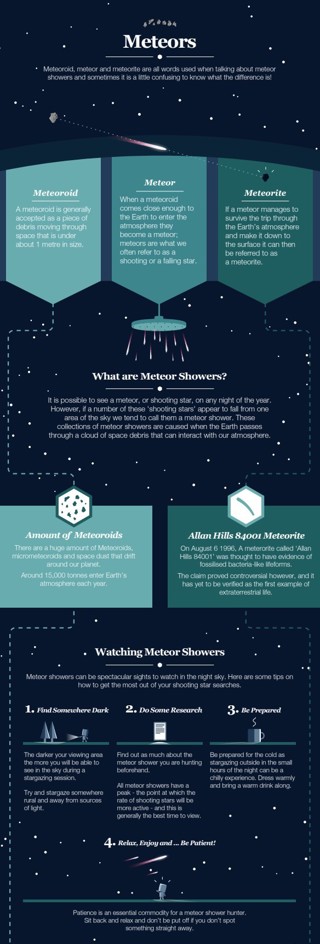
Geminid Meteor Shower 2023
- 11th Dec 2023
- Author: Team Discovery (edited: Dhara Patel)
Geminids
The Geminids are caused by the Earth passing through the debris left behind by asteroid 3200 Phaethon. Most meteors showers are associated with the debris left by comets, but Phaethon was the first asteroid to be associated with a meteor shower, the Geminids. Exactly how this rocky asteroid produces enough debris to create the Geminids is still a mystery, considering it doesn’t have a tail nor does it appear to shed much debris, even when it’s close to the Sun.
Nevertheless the debris is there and as the Earth ploughs into the debris stream every year, the debris heats up in our atmosphere and disintegrates in flashes of light that we call meteors.
The Geminids are normally the most intense meteor shower of the year, producing up to 120 meteors an hour, so even in less-than-ideal conditions, it’s a great one to hedge a bet on to spot some meteors.
How to Watch from the UK
The Geminids are named after the constellation Gemini as this is the direction from which they appear to originate from. While the meteors appear to radiate out from a part of Gemini, they are best seen 30 degrees away from their origin. So be sure to face Gemini which will appear in the south-east around midnight but keep careful watch across the whole sky.
To view the Geminids from the UK, head outside and view during the hours around midnight.
Look up and keep an eye on the whole sky. Using a deck chair can make this much more comfortable especially if you plan on being out for a few hours. And in the midst of winter, some comforts like a blanket and thick coat along with a hot drink might make for a better experience.
Plan ahead, check the weather forecast and find a location as far from city lights as you can and give your eyes 30 minutes in the darkness to adjust to seeing fainter objects. If you have to use any gadgets, use the red-light mode on them.
The waxing crescent moon in the constellation of Sagittarius will set just after the Sun on 14 December, so moonlight won't cause interference with viewing throughout the night.
Geminid meteors tend to be bright and often of various colours so they're definitely worth heading out for. Appearing mainly white and yellow; some will glow red, green and blue, caused by the trace amounts of different metals in the debris.
The Geminids are active between 4-20 December. Whilst this years peak falls during the early evening on 14 December, it would be worth observing the night before too.
Meteor Infographic
Download our National Space Centre Meteor Shower Guide to make sure you are fully prepared!
Other upcoming meteor showers for 2023 include:
Ursids
Comet of Origin: 8P/Tuttle
Radiant: constellation Ursa Minor
Peak Activity: Dec. 21-22, 2023
Peak Activity Meteor Count: 5-10 meteors per hour
And stay tuned in 2024 for more meteor showers:
Quadrantids
Comet of Origin: The cause of the Quadrantids is a bit of a mystery, but it’s thought that the asteroid 2003 EH1 is the source of the debris.
Radiant: the northern tip of Boötes
Peak Activity: 3-4 January 2024
Peak Activity Meteor Count: up to 110 meteors per hour
Lyrids
Comet of Origin: C/1861 G1 (Thatcher)
Radiant: constellation Lyra
Peak Activity: 21-22 April 2024
Peak Activity Meteor Count: 10-20 meteors per hour
Eta Aquariids
Comet of Origin: 1P/Halley
Radiant: constellation Aquarius
Peak Activity: 5-6 May 2024
Peak Activity Meteor Count: up to 50 meteors per hour
Delta Aquariids
Comet of Origin: 96P/Machholz
Radiant: constellation Aquarius
Peak Activity: 30 July 2024
Peak Activity Meteor Count: up to 10 meteors per hour
Perseids
Comet of Origin: 109P/Swift-Tuttle
Radiant: constellation Perseus
Peak Activity: 12-13 August 2024
Peak Activity Meteor Count: up to 100 meteors per hour
Draconids
Comet of Origin: 21P/Giacobini-Zinner
Radiant: constellation Draco
Peak Activity: 8-9 October 2024
Peak Activity Meteor Count: up to 10 meteors per hour (In rare instances, fiery Draco has been known to spew forth many hundreds of meteors in a single hour.)
Orionids
Comet of Origin: 1P/Halley
Radiant: constellation Orion
Peak Activity: 21-22 October 2024
Peak Activity Meteor Count: up to 20 meteors per hour
Northern Taurids
Comet of Origin: 2P/Encke
Radiant: constellation Taurus
Peak Activity: 11-12 November 2024
Peak Activity Meteor Count: 5 meteors per hour
Leonids
Comet of Origin: 55P/Tempel-Tuttle
Radiant: constellation Leo
Peak Activity: 16-17 November 2024
Peak Activity Meteor Count: up to 10 meteors per hour
Geminids
Asteroid of Origin: 3200 Phaethon
Radiant: constellation Gemini
Peak Activity: 13-14 December 2024
Peak Activity Meteor Count: up to 150 meteors per hour
Ursids
Comet of Origin: 8P/Tuttle
Radiant: constellation Ursa Minor
Peak Activity: 21-22 December 2024
Peak Activity Meteor Count: up to 10 meteors per hour
Happy meteor-gazing!
Full references / credits:
(Banner image) Meteor showers. Credit: © National Space Centre
(1) Geminid over Temple Mountain, Utah in 2017. Credit: Shannon Dizmang CC BY-NC-ND 4.0 (https://www.flickr.com/photos/dizmangphotography/39417320471/in/photolist-234b56D-C5nKbr-ptbmKV-dB1FrE-7nKrKk-inDGue-q7SkL3-2kguq9B-7nNR1d-qqe4ZJ-CmH3Z3-2ct5uTU-fftkFd-C5mJdg-AdRvxx-ibMQCZ-2o61gyG-2khTU4H-2kh36BC-cmNy-Hy8uqn-2khst8r-CT38sp-qefGNU-2kh9Tm2-q7Wdk4-dBgz85-2mQCNLV-CcJWig-2kg7kQV-q8d4Sa-dBVMSR-dAMLJm-2kkrqJh-dB4huE-dAXDSe-dEsYDJ-2kgyymz-pukXBW-ijgCcR-CPk8i4-2o61zp1-2o8uifL-22rVHhy-928yDw-BfaJTY-dBadkY-219s8Qv-92BLCD-21ajDyP)
(2) Radiant of the Geminids. Credit: Stellarium




